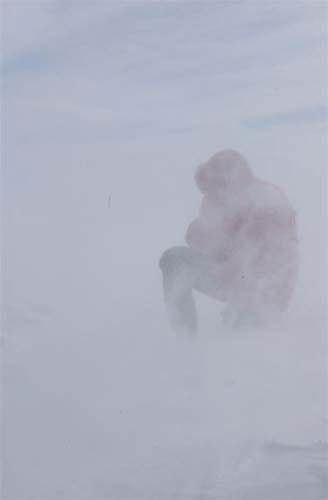Behandling av alvorlig nedkjøling, hypotermi
Ved alvorlig hypotermi vil den nedkjøltes bevissthet gradvis svekkes, og vedkommende vil kunne bli bevisstløs. Behandlingen må gjennomføres varsomt.

Sist oppdatert:
30. des. 2019
Hva er alvorlig nedkjøling?

Nedkjøling deles inn i mild hypotermi (kroppstemperatur 32-35 °C), moderat hypotermi (28-32 °C), alvorlig hypotermi (20-28 °C) og dyp hypotermi (< 20 °C). Ved moderat og alvorlig hypotermi vil den nedkjøltes bevissthet gradvis svekkes, og vedkommende blir etter hvert bevisstløs. Han eller hun skjelver ikke lenger, pusten er svak, pulsen er vanskelig å kjenne, huden er iskald og vedkommende blir etter hvert urørlig.
En alvorlig nedkjølt person trenger førstehjelp og må innleggelse i sykehus for intensiv behandling.
Vil du vite mer
Dette dokumentet er basert på det profesjonelle dokumentet Hypotermi . Referanselisten for dette dokumentet vises nedenfor
- Rudolph SF, Mantoni T, Belhage B. Patofysiologi ved accidentel hypotermi. Ugeskr Læger 2007; 169: 3845-9. Ugeskrift for Læger
- Brown DJA, Brugger H, Boyd J, Paal P. Accidental hypothermia. Review article. N Engl J Med 2012; 367: 1930-8. doi:10.1056/NEJMra1114208 DOI
- Epstein E, Anna K. Accidental hypothermia. BMJ 2006; 332: 706-9. PubMed
- Durrer B, Brugger H, Syme D. The medical on-site treatment of hypothermia: ICAR-MEDCOM recommendation. High Alt Med Biol 2003;4:99-103. PMID: 12713717 PubMed
- Rathjen NA, Shahbodaghi SD. Hypothermia and Cold Weather Injuries. Am Fam Physician 2019; 100: 680-6. American Family Physician
- Dobson JA, Burgess JJ. Resuscitation of severe hypothermia by extracorporeal rewarming in a child. J Trauma 1996; 40: 483-5. PubMed
- Gilbert M, Busund R, Skagseth A, Nilsen PA, Solbo JP. Resuscitation from accidental hypothermia of 13.7 degrees C with circulatory arrest. Lancet 2000; 355: 375-6. PubMed
- Hylen Ranhoff A. Aksidentell hypotermi hos eldre. Tidsskr Nor Lægeforen 2002; 122: 715-7. PubMed
- Vassal T, Benoit-Gonin B, Carrat F, Guidet B, Maury E, Offenstadt G. Severe accidental hypothermia treated in an ICU: prognosis and outcome. Chest 2001; 120: 1998-2003. PubMed
- Zafren K, Giesbrecht GG, Danzl DF, et al. Wilderness Medical Society practice guidelines for the out-of-hospital evaluation and treatment of accidental hypothermia: 2014 update. Wilderness Environ Med. 2014;25(4 suppl):S66–S85. PMID: 25498264. PubMed
- Kjærgaard B, Rudolph SF, Lucas A, Holdgaard HO. Behandling af den hypoterme patient. Ugeskr Læger 2008; 170: 2005-10. PubMed
- Hilmo J, Naesheim T, Gilbert M. «Nobody is dead until warm and dead»: prolonged resuscitation is warranted in arrested hypothermic victims also in remote areas–a retrospective study from northern Norway. Resuscitation 2014; 85: 1204 – 11. PMID: 24882104 PubMed
- McCullough L, Arora S: Diagnosis and treatment of hypothermia. Am Fam Phys 2004; 70: 2325-32. PubMed
- American Heart Association guidelines for cardiopulmonary resuscitation and emergency cardiovascular care part 10.4: Hypothermia. Circulation 2005; 112: 136-8. Circulation
- Nasjonal kompetansetjeneste for traumatologi. Faglig retninglinje for håndtering av aksidentell hypotermi. Oslo: Nasjonal kompetansetjeneste for traumatologi; 2016. traumatologi.no
- Drinane J, Kotamarti VS, O'Connor C, et al. Thrombolytic salvage of threatened frostbitten extremities and digits: a systematic review published online ahead of print June 11, 2019. J Burn Care Res. 2019. Accessed August 6, 2019. PMID: 31188429 PubMed
- Soreide E, Grahn DA, Brock-Utne JC, Rosen L. A non-invasive means to effectively restore normothermia in cold stressed individuals: a preliminary report. J Emerg Med 1999; 17: 725-30. PubMed
- Walpoth BH, Walpoth-Aslan BN, Mattle HP, Radanov BP, Schroth G, Schaeffler L, et al. Outcome of survivors of accidental deep hypothermia and circulatory arrest treated with extracorporeal blood warming. N Engl J Med 1997; 337: 1500-5. New England Journal of Medicine
- Brunette DD, McVaney K. Hypothermic cardiac arrest: an 11 year review of ED management and outcome. Am J Emerg Med 2000; 18: 418-22. American Journal of Emergency Medicine
- Fudge JR, Bennett BL, Simanis JP, et al. Medical evaluation for exposure extremes: cold. Wilderness Environ Med. 2015;26(4 suppl):S63–S68. PMID: 26617380. PubMed
- Guidelines 2000 for cardiopulmonary resuscitation and emergency cardiovascular care. Part 8: advanced challenges in resuscitation: section 3: special challenges in ECC. Hypothermia. The American Heart Association in collaboration with the International Liaison Committee on Resuscitation. Circulation 2000; 102 (8 suppl): I229-32.
- Rudolph SF, Mantoni T, Belhage B. Patofysiologi ved accidentel hypotermi. Ugeskr Læger 2007; 169: 3845-9. PubMed
- Mair P, Brugger H, Mair B, et al. Is extracorporeal rewarming indicated in avalanche victims wit unwitnessed hypothermic cardiorespiratory arrest?. High Alt Med Biol 2014; 15: 500-3. doi:10.1089/ham.2014.1066 DOI